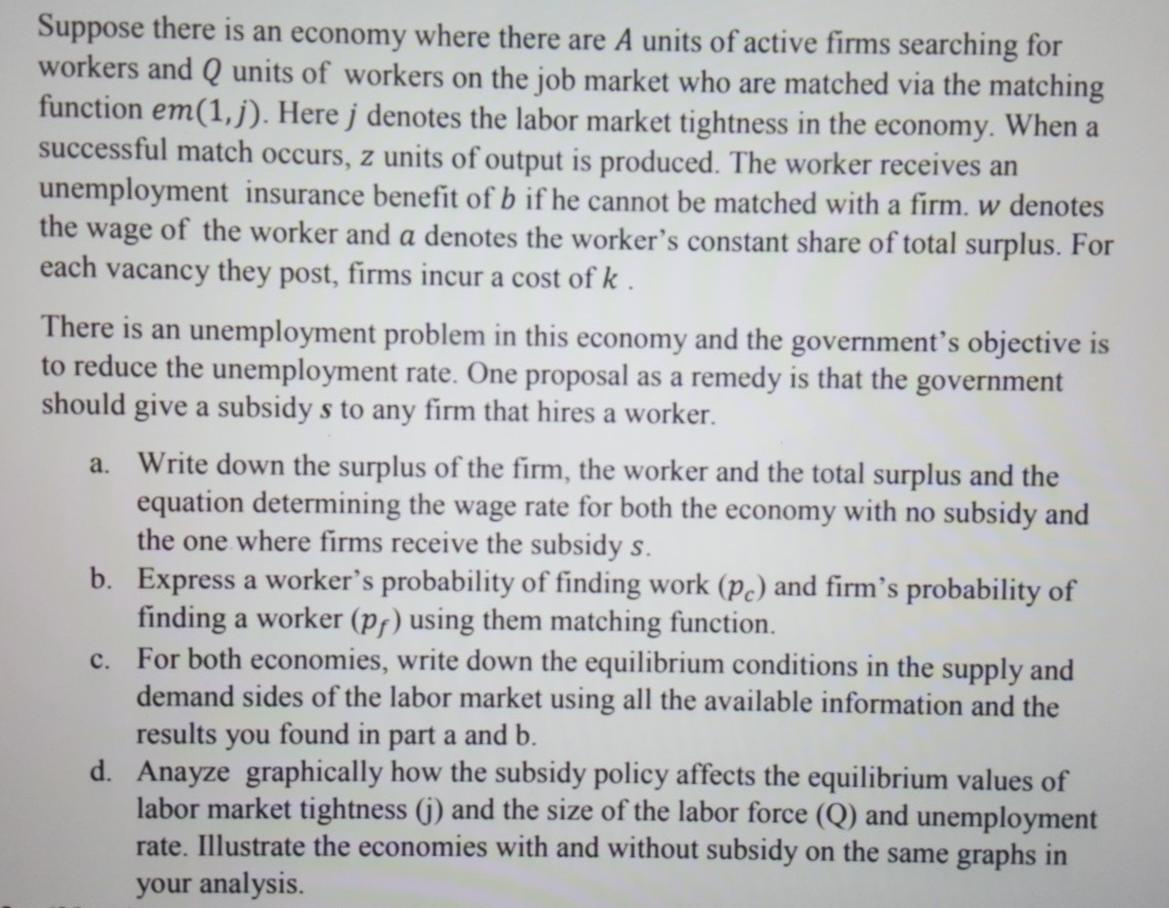Answered step by step
Verified Expert Solution
Question
1 Approved Answer
Suppose there is an economy where there are A units of active firms searching for workers and Q units of workers on the job

Suppose there is an economy where there are A units of active firms searching for workers and Q units of workers on the job market who are matched via the matching function em(1, j). Here j denotes the labor market tightness in the economy. When a successful match occurs, z units of output is produced. The worker receives an unemployment insurance benefit of b if he cannot be matched with a firm. w denotes the wage of the worker and a denotes the worker's constant share of total surplus. For each vacancy they post, firms incur a cost of k . There is an unemployment problem in this economy and the government's objective is to reduce the unemployment rate. One proposal as a remedy is that the government should give a subsidy s to any firm that hires a worker. a. Write down the surplus of the firm, the worker and the total surplus and the equation determining the wage rate for both the economy with no subsidy and the one where firms receive the subsidy s. b. Express a worker's probability of finding work (p.) and firm's probability of finding a worker (pf) using them matching function. c. For both economies, write down the equilibrium conditions in the supply and demand sides of the labor market using all the available information and the results you found in part a and b. d. Anayze graphically how the subsidy policy affects the equilibrium values of labor market tightness (j) and the size of the labor force (Q) and unemployment rate. Illustrate the economies with and without subsidy on the same graphs in your analysis. Suppose there is an economy where there are A units of active firms searching for workers and Q units of workers on the job market who are matched via the matching function em(1, j). Here j denotes the labor market tightness in the economy. When a successful match occurs, z units of output is produced. The worker receives an unemployment insurance benefit of b if he cannot be matched with a firm. w denotes the wage of the worker and a denotes the worker's constant share of total surplus. For each vacancy they post, firms incur a cost of k . There is an unemployment problem in this economy and the government's objective is to reduce the unemployment rate. One proposal as a remedy is that the government should give a subsidy s to any firm that hires a worker. a. Write down the surplus of the firm, the worker and the total surplus and the equation determining the wage rate for both the economy with no subsidy and the one where firms receive the subsidy s. b. Express a worker's probability of finding work (p.) and firm's probability of finding a worker (pf) using them matching function. c. For both economies, write down the equilibrium conditions in the supply and demand sides of the labor market using all the available information and the results you found in part a and b. d. Anayze graphically how the subsidy policy affects the equilibrium values of labor market tightness (j) and the size of the labor force (Q) and unemployment rate. Illustrate the economies with and without subsidy on the same graphs in your analysis.
Step by Step Solution
★★★★★
3.53 Rating (146 Votes )
There are 3 Steps involved in it
Step: 1
Answer a Marketdominant firms are referred to as price makers They can increase prices and modify th...
Get Instant Access to Expert-Tailored Solutions
See step-by-step solutions with expert insights and AI powered tools for academic success
Step: 2

Step: 3

Ace Your Homework with AI
Get the answers you need in no time with our AI-driven, step-by-step assistance
Get Started


